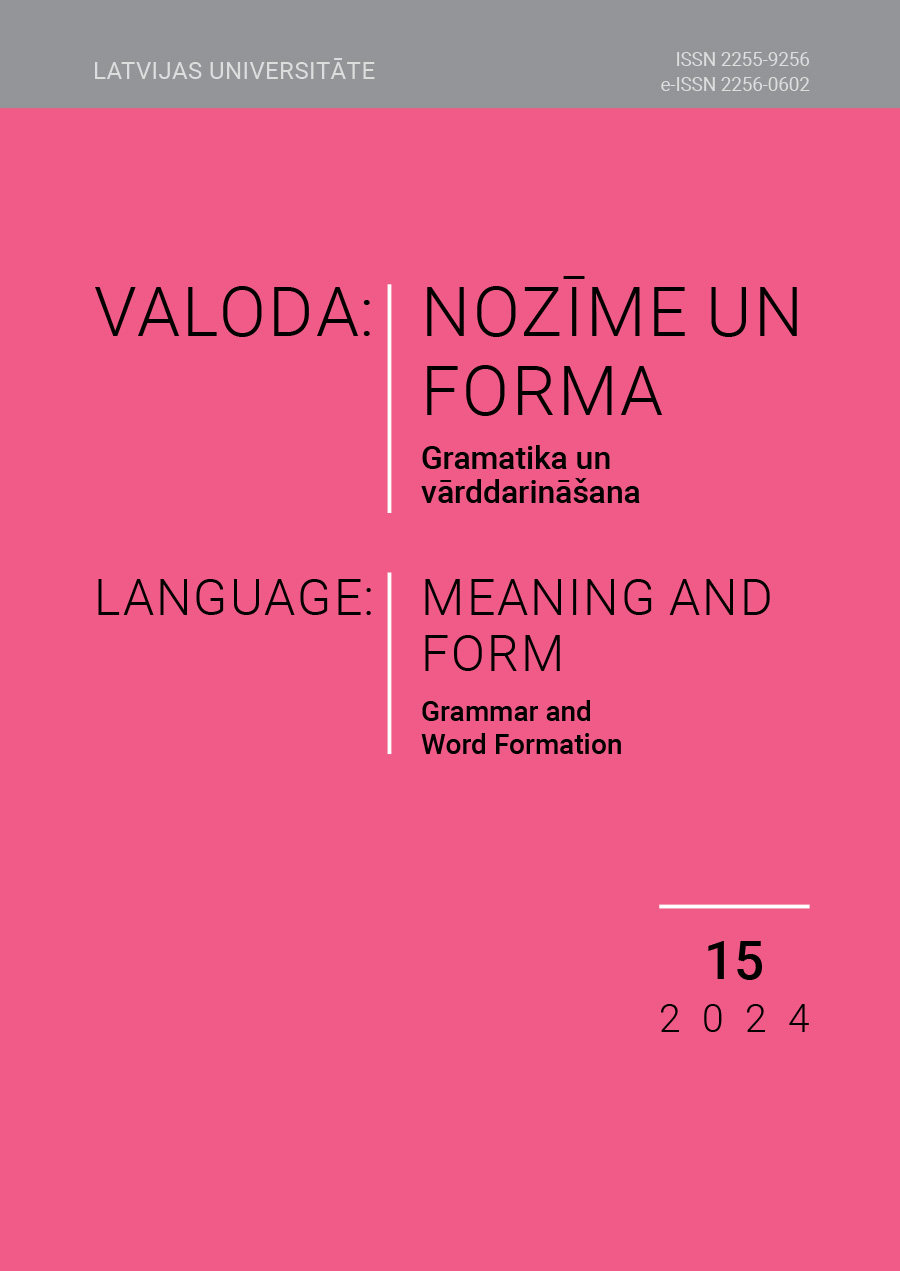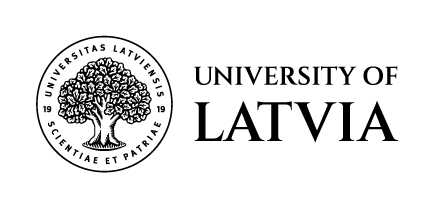The use of substantives’ suffixes -in- and -īn- in the Latvian language of Būtingė and Šventoji
DOI:
https://doi.org/10.22364/vnf.15.12Keywords:
substantives, suffixes, word-formation, word’s meaning, subdialect, Būtingė, ŠventojiAbstract
Lower Kurzeme subdialects contain many productive word-formation suffixes, such as -el-, -en-, -n-, -ien-, -in-, -īn-, -īt-. The Latvian language of Būtingė and Šventoji, which today belongs to the Latvian (Curonian) cultural space in the north-west of Lithuania at the Baltic Sea, with its cultural and historical traditions, also belongs both to Rucava cultural space and broader cultural and linguistic scenery of Lower Kurzeme. The article reflects the research dedicated to the dynamics of the two most productive word-formation suffixes, -in- and -īn-, in the Latvian language of Būtingė and Šventoji, noting the common traits with Lower Kurzeme subdialects and emphasising the features and quantitative indicators which are different. The material of research consists of the language recordings (2008–2021) from Būtingė and Šventoji, which were decoded by the author, and the language examples from Kurzeme Institute of Humanities expeditions published in the book “From Šventoji to Ance” (2008).
The research material also includes the decodings of the 21st-century language of people from Būtingė and Šventoji who moved to Latvia in the 1960s. The main research methods used in the study are the analytical method and the comparative method. All substantives with suffixes -in- and -īn- were excerpted. The comparative method was used to examine the intensity of use of the substantives with suffixes -in- and -īn- in the older, middle, and younger generations in different thematic groups and compare the language material with Lower Kurzeme subdialects and the north-western subdialects of the Lithuanian language’s Samogitian dialect. The study has yielded a conclusion that substantives with the suffixes -in- and -īn- are mainly words of neutral meanings that do not express the meaning of a diminutive; their use at the beginning of the 21st century in the Latvian language of Būtingė and Šventoji is common in the language of the older and middle generations. A large part of derivatives with the suffix -in- in the Latvian language of Būtingė and Šventoji are personal names derived from masculine personal names.
References
Balkevičs, Jons et al. 1995. Lietuviešu-latviešu vārdnīca. Rīga: Zinātne.
Bušmane, Brigita. 2020. Nīcas izloksnes vārdnīca (J–Ķ). Rīga: Latvijas Universitātes Latviešu valodas institūts. Pieejams: http://lavi.lu.lv/wp-content/uploads/2021/03/NIV-J-K-publicesanai-30.06.2020.pdf
Endzelīns, Jānis, Hauzenberga, Edīte. 1934–1946. Papildinājumi un labojumi Kārļa Mīlenbaha Latviešu valodas vārdnīcai. Rīga: Kultūras fonds.
Fraenkel, Ernst. 1955–1965. Litauisches etymologisches Wörterbuch. 1–2. Heidelberg: Carl
Winter.
Laumane, Benita (red.). 2008. No Sventājas līdz Ancei: Latviešu izloksnes Rietumkurzemes piekrastē 20. gs. beigās / 21. gs. sākumā. Liepāja: LiePA.
Liepājas Universitātes Kurzemes Humanitārā institūta apvidvārdu kartotēka. 2000–2016.
Mīlenbahs, Kārlis. 1923–1932. Latviešu valodas vārdnīca. Rediģējis, papildinājis, turpinājis Jānis Endzelīns. 1–4. Rīga: Izglītības ministrija, Kultūras fonds.
Naktinienė, Gertrūda. 2005. Lietuvių kalbos žodynas. Elektroninis variantas. Vilnius: Lietuvių kalbos institutas. Pieejams: http://www.lkz.lt
Straupeniece, Daiga. 2008–2021. Audiomateriālu ieraksti Būtiņģē un Sventājā.
Straupeniece, Daiga. 2015–2021. Audiomateriālu ieraksti Liepājā.
Vanagienė, Birutė. 2014–2015. Šiaurės vakarų žemaičių žodynas. I–II. Vilnius: Lietuvių kalbos institutas.
Ābele, Anna. 1927. Par Rucavas izloksni. Filologu biedrības raksti. VII, 112–128.
Ābele, Anna. 1929. Gramzda draudzes izloksne. Filologu biedrības raksti. IX, 89–113.
Bušmane, Brigita. 1989. Nīcas izloksne. Rīga: Zinātne.
Bušmane, Brigita. 2001. Ēdienu nosaukumi Sventājas latviešu valodā. Vārds un tā pētīšanas aspekti. 5, 68–89.
Bušmane, Brigita. 2004. Lejaskurzemes leksika tautasdziesmās un mūsdienu izloksnēs. Mana novada valoda: Lejaskurzeme. Laumane, Benita (red.). Liepāja: LiePA, 128–179.
Bušmane, Brigita. 2007. Ēdieni un to nosaukumi Rucavā. Rucavā, tur Paurupē... Etnogrāfija, folklora, valoda. Laumane, Benita, Ozola, Ieva, Girņus, Gita (red.). Liepāja: LiePA, 252–292.
Endzelīns, Jānis. 1951. Latviešu valodas gramatika. Rīga: Latvijas Valsts izdevniecība.
Jansone, Ilga. 2003. Galvas segas un plecu segas: lingvistiskais aspekts latviešu valodā. Rīga: Latvijas Universitātes Latviešu valodas institūts.
Kalnača, Andra. 2015. Latvian. Edinburgh Handbook of Evaluative Morphology. Grandi, Nicola, Körtvélyessy, Lívia (eds.). Edinburgh: Edinburgh University Press, 253–261.
Laumane, Benita (red.). 1999. Latviešu valodas dialektu atlants. Leksika. Rīga: Zinātne.
Laumane, Benita, Ozola, Ieva, Girņus, Gita (red.). 2007. Rucavā, tur Paurupē... Etnogrāfija, folkora, valoda. Liepāja: LiePA.
Markus-Narvila, Liene. 2016. Dienvidrietumkurzemes izloksnes: Bārta, Rucava. Avoti vēl neizsīkst. Stafecka, Anna (red.). Rīga: Latvijas Universitātes Latviešu valodas institūts.
Ozola, Ieva, Markus-Narvila, Liene. 2021. Valoda. Laiks. Lejaskurzeme. Liepāja, Rīga: Liepājas Universitāte, Latvijas Universitātes Latviešu valodas institūts.
Rudzīte, Marta. 1964. Latviešu dialektoloģija. Rīga: Latvijas Valsts izdevniecība.
Rūķe-Draviņa, Velta. 1959. Diminutive im Lettischen. Lund: Lindsteds Universität Bokhandel.
Stafecka, Anna (red.). 2021. Latviešu valodas dialektu atlants. Morfoloģija I. Apraksts, kartes un to komentāri. Rīga: Latvijas Universitātes Latviešu valodas institūts, Zinātne.
Straupeniece, Daiga. 2018. Latviešu valoda Lietuvā – Būtiņģē un Sventājā. Liepāja: LiePA.
Valtere, Emma. 1938. Pērkones izloksne. Filologu biedrības raksti. XVIII, 123–135.
Vulāne, Anna. 1986. Adjektīvu ar -inis, -ine derivācija un atributīvā funkcija augšzemnieku dialektā. Latvijas PSR Zinātņu akadēmijas Vēstis. 1 (462), 73–84.
Vulāne, Anna. 2013. Vārddarināšana. Latviešu valodas gramatika. Nītiņa, Daina, Grigorjevs, Juris (red.). Rīga: Latvijas Universitātes Latviešu valodas institūts, 190–299.
Downloads
Published
Issue
Section
License

This work is licensed under a Creative Commons Attribution-NoDerivatives 4.0 International License.


